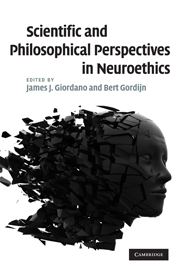Book contents
- Frontmatter
- Contents
- List of contributors
- Preface
- Acknowledgments
- Introduction
- 1 Developments in neuroscience
- 2 The origins of the modern concept of “neuroscience”
- 3 On the cusp
- 4 The mind-body issue
- 5 Personal identity and the nature of the self
- 6 Religious issues and the question of moral autonomy
- 7 Toward a cognitive neurobiology of the moral virtues
- 8 From a neurophilosophy of pain to a neuroethics of pain care
- 9 Transplantation and xenotransplantation
- 10 Neurogenetics and ethics
- 11 Neuroimaging
- 12 Can we read minds?
- 13 Possibilities, limits, and implications of brain-computer interfacing technologies
- 14 Neural engineering
- 15 Neurotechnology as a public good
- 16 Globalization: pluralist concerns and contexts
- 17 The human condition and strivings to flourish
- 18 The limits of neuro-talk
- Afterword
- Index
9 - Transplantation and xenotransplantation
Published online by Cambridge University Press: 07 May 2010
- Frontmatter
- Contents
- List of contributors
- Preface
- Acknowledgments
- Introduction
- 1 Developments in neuroscience
- 2 The origins of the modern concept of “neuroscience”
- 3 On the cusp
- 4 The mind-body issue
- 5 Personal identity and the nature of the self
- 6 Religious issues and the question of moral autonomy
- 7 Toward a cognitive neurobiology of the moral virtues
- 8 From a neurophilosophy of pain to a neuroethics of pain care
- 9 Transplantation and xenotransplantation
- 10 Neurogenetics and ethics
- 11 Neuroimaging
- 12 Can we read minds?
- 13 Possibilities, limits, and implications of brain-computer interfacing technologies
- 14 Neural engineering
- 15 Neurotechnology as a public good
- 16 Globalization: pluralist concerns and contexts
- 17 The human condition and strivings to flourish
- 18 The limits of neuro-talk
- Afterword
- Index
Summary
INTRODUCTION
Although adult-to-adult organ transplantation has developed in the past 50 years in the surgical arenas, neurosurgeons have had no options to take out damaged brain areas and to implant new tissue from adult donors. Adult neurons do not survive isolation and transplantation. The neurosurgeon, moreover, cannot take out malfunctioning brain tissue or cells without severely damaging the nervous system in its still intact parts. However, the possibility of neural tissue repair by implantation rather than by transplantation became an option, with observations in animal research that has shown that immature nerve cells not only survive and mature following implantation in the adult nervous system, but also integrate and become functionally active in existing networks. Implantation of neurons to supplement lost neurons in cases of neurodegenerative diseases and neurotrauma thus became a challenging perspective for the neurosurgeon.
Parkinson's disease (PD) was the test bed disease for this approach, as it is primarily characterized by a defined loss of neurons in the substantia nigra serving a dopaminergic input in the striatum of the central nervous system (CNS). Grafting fetal substantia nigra dopaminergic cells into the striatum of substantia nigra-lesioned rats reversed the motor disturbances, and similar studies in non-human primate models were successful as well. These results prompted clinical trials with human fetal dopaminergic neurons implanted into the striatum of PD patients. The grafted neurons indeed survived and became active cells as shown by functional brain scans.
- Type
- Chapter
- Information
- Scientific and Philosophical Perspectives in Neuroethics , pp. 190 - 215Publisher: Cambridge University PressPrint publication year: 2010
- 2
- Cited by



